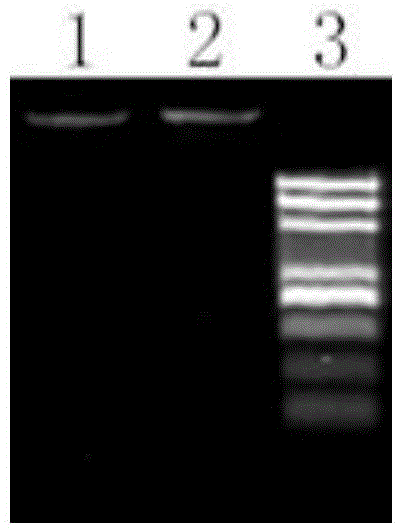Kit and extraction method for quickly extracting microbial genome DNA from animal fecal microorganisms
A technology of animal feces and extraction methods, applied in the biological field, can solve the problems of inability to identify bacteria at the species level, a large amount of labor and time, and achieve the effects of saving extraction time and simplifying experimental steps
- Summary
- Abstract
- Description
- Claims
- Application Information
AI Technical Summary
Problems solved by technology
Method used
Image
Examples
Embodiment 1
[0054] A kit for rapidly extracting microbial genomic DNA from animal feces, which consists of a DNA adsorption column and the following working solution:
[0055] Working solution A: composed of potassium dihydrogen phosphate with a final concentration of 0.25mol / L and sodium hydroxide with a final concentration of 0.175mol / L, pH=7.2;
[0056] Working solution B: composed of tris (Tris) at a final concentration of 10mmol / L and ethylenediaminetetraacetic acid (EDTA) at a final concentration of 1mmol / L, pH=8.0;
[0057] Working solution C: 10mg / ml lysozyme;
[0058] Working solution D: 20mg / ml proteinase K;
[0059] Working solution E: sodium dodecyl sulfate (SDS) with a mass concentration of 10%;
[0060] Working solution F: the volume ratio is a mixed solution of phenol: chloroform: isoamyl alcohol=25:24:1;
[0061] Working solution G: the volume ratio is a mixed solution of chloroform:isoamyl alcohol=24:1;
[0062] Precipitating agent: mass concentration 70% ethanol;
...
Embodiment 2
[0068] A kit for rapidly extracting microbial genomic DNA from animal feces, which consists of a DNA adsorption column and the following working solution:
[0069] Working solution A: composed of potassium dihydrogen phosphate with a final concentration of 0.30mol / L and sodium hydroxide with a final concentration of 0.185mol / L, pH=7;
[0070] Working solution B: composed of tris (Tris) at a final concentration of 15mmol / L and ethylenediaminetetraacetic acid (EDTA) at a final concentration of 5mmol / L, pH=6.5;
[0071] Working solution C: 30mg / ml lysozyme;
[0072] Working solution D: 35mg / ml proteinase K;
[0073] Working solution E: sodium dodecyl sulfate (SDS) with a mass concentration of 10-20%;
[0074] Working solution F: the volume ratio is a mixed solution of phenol: chloroform: isoamyl alcohol=25:24:1;
[0075] Working solution G: the volume ratio is a mixed solution of chloroform:isoamyl alcohol=24:1;
[0076] Precipitating agent: mass concentration 75% ethanol;
...
Embodiment 3
[0082] A kit for rapidly extracting microbial genomic DNA from animal feces, which consists of a DNA adsorption column and the following working solution:
[0083] Working solution A: composed of potassium dihydrogen phosphate with a final concentration of 0.37mol / L and sodium hydroxide with a final concentration of 0.2mol / L, pH=8;
[0084] Working solution B: composed of tris (Tris) at a final concentration of 20mmol / L and ethylenediaminetetraacetic acid (EDTA) at a final concentration of 10mmol / L, pH=5.0;
[0085] Working solution C: 50mg / ml lysozyme;
[0086] Working solution D: 50mg / ml proteinase K;
[0087] Working solution E: sodium dodecyl sulfate (SDS) with a mass concentration of 10-20%;
[0088] Working solution F: the volume ratio is a mixed solution of phenol: chloroform: isoamyl alcohol=25:24:1;
[0089] Working solution G: the volume ratio is a mixed solution of chloroform:isoamyl alcohol=24:1;
[0090] Precipitating agent: mass concentration 80% ethanol;
...
PUM
 Login to View More
Login to View More Abstract
Description
Claims
Application Information
 Login to View More
Login to View More - R&D
- Intellectual Property
- Life Sciences
- Materials
- Tech Scout
- Unparalleled Data Quality
- Higher Quality Content
- 60% Fewer Hallucinations
Browse by: Latest US Patents, China's latest patents, Technical Efficacy Thesaurus, Application Domain, Technology Topic, Popular Technical Reports.
© 2025 PatSnap. All rights reserved.Legal|Privacy policy|Modern Slavery Act Transparency Statement|Sitemap|About US| Contact US: help@patsnap.com

